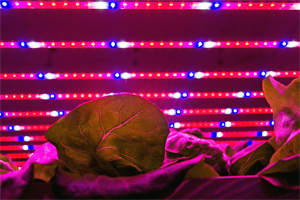Can Colored Lights Affect How Plants Grow?
Everyone knows plants are food factories, and most are aware that their energy source is light. This transformation of light into food is called photosynthesis. What may be news to you, however, is that the color of the light has a measurable impact on the amount of energy a plant absorbs. The reason for this is the colors in light have different wavelengths and those wavelengths, depending on whether they are short or long, provide different levels of energy.
The highest energy light is at the purple or violet end of the color light spectrum. Purple and violet lights have short wavelengths and thus lots of energy. At the other end of the spectrum, you will find red light which has long wavelengths and emits lower energy.
Regardless of whether the color of the light is red or purple the plant will absorb some amount of energy from the light it is receiving. Green light is the least effective for plants because they are themselves green due to the pigment Chlorophyll.
Different colored lights help plants achieve different goals. Blue light, for example, helps encourage vegetative leaf growth. Red light, when combined with blue, allows plants to flower.
Knowing that different colors of light can affect what a plant does is important in a world that depends on plants for food. Advanced LED technology is now making it possible to control the kinds of colored light we provide plants in controlled environments.
We can now design lighting to encourage flowering or to produce higher fruit yields for example. Many plant functions can be enhanced and promoted just by knowing what light colors they react and respond to.
A light meter with the ability to measure and calculate spectral data to confirm the energy in the colored lights are correctly correlated with the color the plant needs for optimum growth.
Konica Minolta Sensing’s CL-500A is such an instrument. The CL-500A is a compact illuminance spectrophotometer used for the evaluation of high-class, next-generation lamps such as LED and EL illumination. It is the first handheld illuminance spectrophotometer to conform to both DIN and JIS standards. The CL-500A can measure illuminance, color temperature, CRI (Color Rendering Index), chromaticity, and spectral power distribution. In addition, the S/P ratio of scotopic illuminance and photopic illuminance can also be displayed. Also available upon request, is its optional ISO 17025 calibration and certification from an accredited metrology lab with a statement of uncertainty included in each calibration certificate.
Using the CL-500A, a spectral irradiance is measurable in distances of 1 nm from 360 to 780nm. This photosynthetically active radiation light wavelength falls within this range and can be measured with the CL-500A illuminance spectrophotometer. Not only can an individual plant’s ideal Daily Light Integral (DIL) be decided but also confirm the correct color lighting is indeed being used. This allows for the lighting within the greenhouse to be adjusted to promote flower growth or larger yields as needed.
Like this article? Click here to sign up for our monthly Light Trends & Technology Newsletter to learn more about the research, evaluation, and measurement of light. By subscribing, you will stay up to date on the latest information on high-quality optical test and measurement instruments and special offers including seminars, webinars, and exclusive promotions.
The technological leader in color and light measurement solutions, Konica Minolta Sensing Americas helps organizations formulate, evaluate, and control color to meet product quality and operational goals more efficiently. To view a summary of lighting solutions visit our Lighting Industry page to learn more and review our Light Meter Brochure.
With the increase in consumer interests in organic plants and foods becoming more popular, this technology provides an environmentally friendly alternatives to help improve crop quality and growth without having to resort to powerful fertilizers and genetically modified food.











